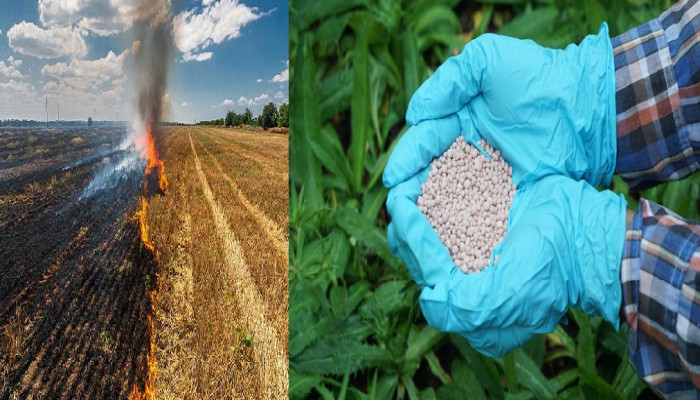From Burning Stubble and Pollution to Solution: Prof. Sabyasachi Sarkar’s Quiet Revolution in Ammonia Synthesis
- In Mathematics, Science & Technology
- 01:20 PM, Sep 15, 2025
- Souptik Mukherjee
From Burning Stubble and Pollution to Solution: Prof. Sabyasachi Sarkar’s Quiet Revolution in Ammonia Synthesis
Sometime back, over a modest cup of tea, I had the privilege of meeting Dr. Sabyasachi Sarkar—a retired professor of chemistry from IIT Kanpur whose eyes still gleam with the fire of discovery. Despite his years in academia, his passion for science remains undiminished, and his words carry the weight of decades of research, experimentation, and quiet perseverance. What began as a casual conversation soon turned into a revelation—one that could redefine how India tackles its most pressing environmental and agricultural challenges.
A Question That Sparked a Gold Mine
I asked him a question that had been gnawing at me for years: Why aren’t Indian scientists able to turn waste into opportunity? Why haven’t we developed low-cost, scalable technologies that address Bharat’s unique problems—especially those that affect our farmers, our air, and our economy?
Dr. Sarkar leaned forward and shared what I now call a “gold mine.” After years of research—from his postdoctoral days to his retirement—he has developed and patented a process to synthesise ammonia using only water, air, burnt hay, and iron as a catalyst. Yes, ammonia—the backbone of fertilisers, a compound central to food security and industrial chemistry—is produced from agricultural waste.
Even more astonishing, the carbon dioxide released during the burning of biomass isn’t wasted. It can be captured and recycled to produce urea, another essential fertiliser. This isn’t just chemistry—it’s alchemy for a nation struggling with pollution, fertiliser imports, and rural distress.
Delhi’s Poison, Punjab’s Stubble, and a Missed Opportunity
As a scientist and resident of Delhi, the implications hit me instantly. Every winter, Punjab and Haryana burn millions of tonnes of stubble to clear their fields. The result? A toxic haze that blankets Delhi, pushing AQI levels into the danger zone and contributing to respiratory diseases, cardiovascular issues, and even cancer.
But what if that same stubble could be repurposed to produce ammonia and urea? Farmers would gain access to more affordable fertilisers. India’s fertiliser import bill—currently among the highest in the world—would shrink. We might even become exporters. The geopolitical implications are enormous, and the environmental benefits are transformative.
The Chemistry Behind the Breakthrough
Dr. Sarkar’s process is grounded in solid, elegant chemistry. It mimics nature’s nitrogen fixation but does so at an industrially viable scale. Here’s how it works:
- Nitrogen and Hydrogen Sources: Air provides nitrogen; water supplies hydrogen.
- Carbon and Energy: Biomass, like burnt hay or low-grade coal, offers carbon and the energy needed to drive the reaction.
- Catalyst: Iron acts as the catalyst, facilitating the formation of ammonia without requiring high pressure or temperature.
The reaction occurs under ambient conditions—no need for the extreme pressures and temperatures of the Haber-Bosch process. It’s simple, scalable, and astonishingly low-cost.
A Glimpse into the Lab Setup
Dr. Sarkar described a basic laboratory setup involving three tubes:
- Tube One (Black): Contains the iron-based catalyst. Air is passed through a basic solution to remove acidic impurities like NO and CO₂. This purified air enters the catalyst chamber.
- Tube Two: Contains an indophenol indicator in dilute sulfuric acid. As ammonia forms and neutralizes the acid, the yellow solution turns blue—an elegant visual confirmation.
- Tube Three: A bubbler with phenolphthalein indicator. Escaped ammonia changes the colourless solution to pink, confirming excess ammonia production.
All of this happens at room temperature, without added pressure. The ammonia is quantified, and its identity confirmed via X-ray crystallography (as ammonium chloride) and NMR spectroscopy.
When the carbon dioxide from the stubble burning is added to the Ammonia, precious Urea can be manufactured at an industrial scale. This holds the potential to transform Bharat and also solve pollution issues.
Lessons from History: Hieber, BASF, and Bosch
Dr. Sarkar reminded me of Fritz Haber, who published his ammonia synthesis in 1905. He patented it in Germany in 1908 and in the U.S. in 1911. To commercialise it, he partnered with BASF, where Carl Bosch took over and scaled the process for industrial use. Haber received the Nobel Prize in 1918, and Bosch followed in 1934.
But it took years of massive support, funding, and institutional backing to bring that lab discovery to the world. In contrast, Dr. Sarkar’s process is already more accessible, less capital-intensive, and tailored for Bharat’s needs. Yet, where are our BASFs and Bosches?
Why Is This Still in the Lab?
This is the question that haunts me. Why hasn’t this breakthrough left the confines of the lab? Why hasn’t it been prototyped, tested, and scaled?
India stands at a crossroads. We can either continue importing expensive fertilisers and choking our cities with pollution, or we can invest in indigenous science that turns waste into wealth. Entrepreneurs, industry leaders, and policymakers must act. The solution is here—quietly waiting for someone to believe in it.
A Civilisational Imperative
As a civilisational nation-state, Bharat must reclaim its scientific spirit. Our low-cost models are under threat globally. We must bank on our scientists—not just for prestige, but for survival. Waste-to-gold technologies like Dr. Sarkar’s are not just innovations; they are lifelines.
This isn’t just about chemistry. It’s about vision, courage, and belief. It’s about recognising that sometimes, the most powerful solutions are born not in billion-dollar labs, but in the quiet corners of a retired professor’s mind—still lit with the fire of discovery.







Comments